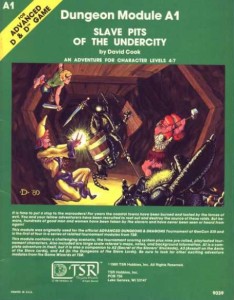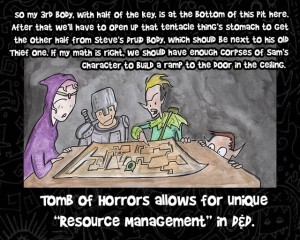Dungeon Crawling: Ten Ways It Is More Than “Hack & Slash”
Posted by Rampant Coyote on April 24, 2015
 I saw an article not long ago that was equating “Dungeon Crawlers” to more action-heavy, monster-bashing RPGs. It’s what we used to call “hack & slash.” The article maintained that this was the essence of old-school D&D.
I saw an article not long ago that was equating “Dungeon Crawlers” to more action-heavy, monster-bashing RPGs. It’s what we used to call “hack & slash.” The article maintained that this was the essence of old-school D&D.
I disagree. Vehemently.
I have no doubt that some people played D&D that way back in the day. I’ve played in those games. The term “hack & slash” was, IIRC, coined back in that era as a way to describe “those kinds” of games. Gamers back then considered it an inferior (and, ultimately, boring) way to play the game, but frequently how the newbies did it because they didn’t know better, and running combat with dice was a novelty. Very few people kept playing that way, because they grew bored and either quit the game, or played the game more as it was … ahem… intended.
If you go over those old modules that epitomized old-school dice & paper “Dungeon Crawling,” you’ll find that at while combat opportunities about, at least in the better-known modules, many of those encounters depart from straight-up fisticuffs. And if you look at one of the best-known (and deadliest) adventures of the 1st edition era, Tomb of Horrors, there is something like a grand total of two combat encounters – and neither are straightforward.
What did they have instead? What did the rest of the classic modules have in spades that defines the “Dungeon Crawling” experience for me, which is very much removed from “Hack & Slash”? This is pretty much my list of “what elements make a CRPG awesome”, but here goes (with some examples):
 #1 – Tactical challenges: Combats with exceptions to them to make things interesting. Usually this involved geography that played to the advantage of the monster being fought. Like the fire giant encounter with narrow walkways along a river of fire – the giant would hurl boulders at party members to knock them off the path and into the flames. Or the demons in Queen of the Demonweb Pits setting high on a perch who would use their telekinetic abilities to lift characters high into the air to engage them – splitting the party and introducing the problem that if you kill the thing that’s keeping you up 150′ in the air… you may still not survive the encounter.
#1 – Tactical challenges: Combats with exceptions to them to make things interesting. Usually this involved geography that played to the advantage of the monster being fought. Like the fire giant encounter with narrow walkways along a river of fire – the giant would hurl boulders at party members to knock them off the path and into the flames. Or the demons in Queen of the Demonweb Pits setting high on a perch who would use their telekinetic abilities to lift characters high into the air to engage them – splitting the party and introducing the problem that if you kill the thing that’s keeping you up 150′ in the air… you may still not survive the encounter.
To get an idea just how nasty these kinds of tactical challenges the players could face when fighting monsters in their home turf, read Roger E. Moore’s editorial about Tucker’s Kobolds. In fact, you want the essence of a good dungeon-crawling, old-school adventure, that’s a fantastic place to begin.
#2 – Role-playing encounters: Theoretically, any encounter was a potential role-playing encounter. But many times, the modules encouraged players to negotiate their way through an encounter – even to the point of making allies in the “dungeon.” And there were some encounters that were likely to end badly if the party opted for the brute-force approach, encouraging stealth, negotiation, or trickery.
#3 – Puzzles! Yep, lots of puzzles. From characters or statues asking riddles, to head-scratching devices that were not only difficult to solve, but difficult to figure why the wizard who built the dungeon would put something like that in his lair.
#4 – Exploration and Secrets: If you look at the Gary Gygax-penned modules, half the treasure (which was worth most of the XP back then — the main source of XP was supposed to be from obtaining treasure, an early form of objective “quest XP”, NOT combat as is commonly and mistakenly believed) was hidden, disguised, or had some other “trick” to obtain it. Or in some cases, hidden in plain view but likely to be disregarded by the players. There were things like a magical sword hanging on a wall that had an illusion cast on it to appear like a torch (I think that one was in The Steading of the Hill Giant Chief, but there were other situations like that), secret panels that could only be opened by the players discovering the trigger, etc.
#5 – Traps – Many of the traps were intended to be discovered and disarmed by role-playing rather than rolls. While entertaining, it did kind of undermine a thief’s major role in the party. But still… it could be lots of fun figuring out how to disarm, avoid, or subvert a complex trap. While I guess modern Diablo-like players might hate the idea, but I loved how the threat of an ambush or trap or other danger around any corner or through any portal paced the game at a more thoughtful level.
 #6 – Resource Management – that was a large part of what the old D&D games were about. You didn’t “clear a level” (let alone a full dungeon) in a single push. Your resources would deplete – health, magic, potions, even food and light sources. You’d make repeated forays into the dungeon, and it was always a case of having to juggle the advantages of pushing ahead with making sure you had enough to safely exit. Which brings us to the next one…
#6 – Resource Management – that was a large part of what the old D&D games were about. You didn’t “clear a level” (let alone a full dungeon) in a single push. Your resources would deplete – health, magic, potions, even food and light sources. You’d make repeated forays into the dungeon, and it was always a case of having to juggle the advantages of pushing ahead with making sure you had enough to safely exit. Which brings us to the next one…
#7 – Reactive, Dynamic Dungeons – the monsters weren’t intended to just sit on their keisters waiting for the party’s next attack. Between forays, the denizens of the dungeon were expected to make changes and mount a better defense the next time around. That required some DM creativity (which could be hard to provide on-the-fly, granted). Monsters would have patrols (or at least there’d be “random encounters” to simulate the same). The monsters were expected to gather or hire reinforcements to assist them the next time around. In very old-school D&D, the dungeons almost had a mind of their own, with rules for doors
#8 – Physical Challenges – there was a standing joke about all the different swimming rules for D&D, because lacking an ‘official’ method at the time some of these modules came out, each designer created their own rule system as one of the challenges in the module. But there was often one or more areas where players needed to either try their luck (and adapt when they failed) climbing / swimming / diving / balancing / jumping / breaking / forcing / racing / dodging / resisting / dancing / whatever, or they needed to figure out a clever way to circumvent or reduce the risk of the challenge.
#9 – Open-Ended Problem Solving: This is a tough one in CRPGs, and many players (and, sadly, DMs of the era) have a tough time wrapping their heads around the idea that you could attempt anything to resolve problems or stack the deck. We think of it as “cheating,” but back then it was simply good playing (within reason). Challenges weren’t necessarily set up to be “fair,” and the spells and abilities weren’t rigidly “balanced” either. You took advantage of what you head. Like the Tucker’s Kobolds story… instead of taking the stairs or elevators you use spikes and ropes to descend an air shaft? Sure. You disintegrate a trapped door rather than deal with the consequences of facing both the trap AND what’s on the other side? Okay. Collapse the ceiling on the hydra rather than fight it? Sure, but it will alert the rest of the dungeon and make collecting the treasure (and the bulk of the XP for the encounter) more challenging.
#10 – Weird, bizarre situations: They’d happen. They made things interesting. They really defied logic and physics even in a magic-rich world sometimes. They broke the “rules.” If overused, they’d get annoying. But once or twice, they were interesting. Things like anti-magic zones, anti-gravity zones, statues that would grant one wish (or the reverse of your wish), “wild magic” areas where anything could happen and spellcasting could be very risky, dimensional gateways, bizarre area illusions, mirrors that would create evil opposites of the party, technology or ideas appropriated from popular movies or books with the barest of rewrites to make them vaguely “fit” in the fantasy setting, that kind of thing.
All this is what I think of when I think “Dungeon crawling.” And yeah, “crawling” is right – the pace was of necessity slower and more methodical. Except when it wasn’t. And sure, it had its share of straight-up battles that wouldn’t be out of place in a Diablo-like. They were great fun, in moderation. But a true, old-school style Dungeon Crawl was, and should be, so much more than that.
Filed Under: Design - Comments: 2 Comments to Read
Weekly Links #67 « No Time To Play said,
[…] over at the Rampant Coyote we have Jay Barnson explaining how in the original Dungeons and Dragons combat was the last resort, not the first, and character progression was tied to gold gathered — a proxy for how much of […]
Lin said,
Dear god, that is a run down of everything I keep looking for and simply don’t find often enough in video games. D&D sure did spoil us, sometimes I forget how much. 🙂 And much of the fun of it obviously can’t ever be really replicated by a computer, because for a group of friends these sets of rules were often just a bunch of flexible, bendable parameters, just waiting to be messed with in an imaginative way. It’s a tall order to expect a row of ones and zeros to pull that one off competently, no matter how thorough a game dev is.
But yes you’re absolutely right, this goes beyond explaining what a dungeon crawler is, I’m happy to vote it “the ultimate list of what makes a crpg awesome”. In fact give me just a couple of the above in a competent package and I’m pretty damn happy for a few hours.